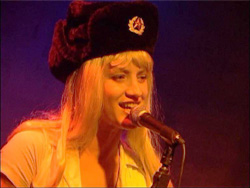| Sun | Mon | Tue | Wed | Thu | Fri | Sat |
|---|---|---|---|---|---|---|
| 1 | 2 | 3 | 4 | 5 | ||
| 6 | 7 | 8 | 9 | 10 | 11 | 12 |
| 13 | 14 | 15 | 16 | 17 | 18 | 19 |
| 20 | 21 | 22 | 23 | 24 | 25 | 26 |
| 27 | 28 | 29 | 30 | 31 |
CATEGORIES
RECENT ENTRIES
BLOG ROLL
Identity politics
Orit Bashkin’s grandparents came to Palestine from Europe in the ’20s and ’30s. They spoke Yiddish, but when they crossed over the border—where Yiddish was rejected as the “language of exile,” Bashkin said—they picked up Hebrew by necessity. Yiddish became "the language of letters and yellowish photos from family in Europe.” But in the 1980s, when her grandparents befriended a set of Russian Jews, they started to speak Yiddish more often. Her grandmother even began to attend Yiddish theater. They were loyal to the mission of Israel—to create a strong, unified Jewish homeland, even if that meant having only Hebrew books in the house—but “you can never erase a culture,” Bashkin said. “You can never erase a memory.”
Bashkin, assistant professor of modern Middle Eastern history at Chicago, appeared on a June 17 panel with assistant professor Na’ama Rokem as part of a program organized by Jan Lisa Huttner, AM’80, of the Chicago YIVO Society. Both Israel-educated Ashkenazi Jews—descendants from Europeans—the professors followed a screening of a 2005 documentary, Ha Ashkenazim, about the Ashkenazi identity movement in Israel, born of young, nostalgic Israelis who want to rediscover their roots.
 According to some of the 20-somethings in the film, Israeli Ashkenazi Jews are thought of as nerdy and weak. Depression and sadness are ingrained in them, and Yiddish is nothing but an outdated language. But one woman, Tammy Ben-Tor (at left), sets Yiddish lyrics to electronica music to try to escape the gloomy language of ancestors who died in the Holocaust and capture the spirit of how they lived: “That’s what I’m interested in,” Ben-Tor says in the movie. “To get their lives back.”
According to some of the 20-somethings in the film, Israeli Ashkenazi Jews are thought of as nerdy and weak. Depression and sadness are ingrained in them, and Yiddish is nothing but an outdated language. But one woman, Tammy Ben-Tor (at left), sets Yiddish lyrics to electronica music to try to escape the gloomy language of ancestors who died in the Holocaust and capture the spirit of how they lived: “That’s what I’m interested in,” Ben-Tor says in the movie. “To get their lives back.”
The rich Ashkenazi identity, the part that is not depressing, said Bashkin, comes from this time before the Holocaust, the culture left behind in the shtetls. Still, she said, the film places too much emphasis on ethnic differences between Ashkenazim and Mizrahi (Arab Jews), who are described as warmer, more rebellious, happier. “In my opinion, ethnic identity is much less pronounced today,” she said. “People team together. You can have Hebrew and you can have other things”—Yiddish, for example—“and the state will not collapse.”
Ruth E. Kott, AM'07
June 25, 2009
